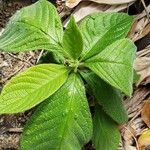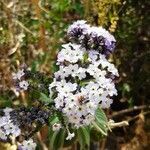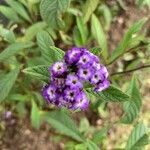Perennial herb, sometimes with woody base, in its original home also shrub up to 2 m high. Stem much branched. Leaves ovate to oblong-elliptic; petiole short, rarely 1-2 cm long; blade 4-8 by 2-4.5 cm, decurrent towards petiole, acute, upper side pubescent or becoming glabrous, lower side paler, with distinct nerves. Inflorescences with many short branchlets, scorpioid, dense, scarcely elongated in fruit, strigose to villous, ebracteate. Calyx nearly sessile, 3-3.5 mm long, not accrescent after flowering, lobes 5, free to the base, subulate-linear. Corolla lavender-purple, tube appressed strigu-lose, twice as long as calyx, limb 4-5 mm in diam., lobes glabrescent, rounded. Stamens: anthers subsessile, crested dorsally by a wavy, antrorse trichome. Pistil: style longer than stigma. Nutlets 4, pitted, ellipsoid.
More
A shrub. It grows 30 cm to 1.3 m high. It can spread 2 m across. The stems are softly hairy. The leaves are oval and 3-8 cm long. The veins pucker the surface. The flowers have a sweet smell. The fruit have 4 nutlets with 1 seed each.
The well known subshrubby ‘cherry pie’, with innumerable cultivars, and scented purplish flowers, is probably widely grown



